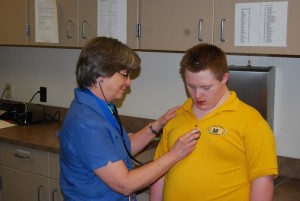 We have all heard that breakfast is the “most important meal of the day” but few people understand why. Not only does it provide the fuel to get your day started, but it might be the cure for those yawns and sleepy eyes during morning class. Breakfast also helps to maintain a healthy weight and may prevent overeating later in the day. So, don’t boogie out the door without breakfast. Need some help? Try these tips:
We have all heard that breakfast is the “most important meal of the day” but few people understand why. Not only does it provide the fuel to get your day started, but it might be the cure for those yawns and sleepy eyes during morning class. Breakfast also helps to maintain a healthy weight and may prevent overeating later in the day. So, don’t boogie out the door without breakfast. Need some help? Try these tips:
1) Make it quick & easy: Mornings are busy. Keep breakfast simple and realistic. If your child doesn’t like breakfast foods, offer dinner leftovers. It’s more important they eat something than skip the morning meal. No time to cook? Cereal with milk and berries is a nutrient-packed breakfast. Toast with peanut butter goes great with a banana. Don’t feel guilty that you didn’t turn on the stove to make breakfast. Feed good that you sent your child out the door with some healthy food in their tummy.
 2) Power up with protein. More and more research is showing that protein for breakfast can keep us feel full longer. Protein rich foods can help prevent tummy growls and hunger pains before lunch. A handful of nuts in trail mix, a spoonful of peanut butter with your apple, or a quick egg sandwich are simple ways to pack your breakfast with protein. Take advantage of the convenience and nutritional benefits of dairy. Enjoy a glass of milk, a cup of yogurt or a piece of string cheese as you’re running out the door, and reap those same benefits of protein to start your day off right.
2) Power up with protein. More and more research is showing that protein for breakfast can keep us feel full longer. Protein rich foods can help prevent tummy growls and hunger pains before lunch. A handful of nuts in trail mix, a spoonful of peanut butter with your apple, or a quick egg sandwich are simple ways to pack your breakfast with protein. Take advantage of the convenience and nutritional benefits of dairy. Enjoy a glass of milk, a cup of yogurt or a piece of string cheese as you’re running out the door, and reap those same benefits of protein to start your day off right.
3) Moooove over juice. Although juice seems like a natural beverage option in the morning, it doesn’t provide many of the nutrients a body needs. Typically only offering few or no nutrients and extra sugar, juice doesn’t serve a grand purpose in a child or adult’s diet. You know what does? Milk! Packed with three of the four nutrients of concern from the 2010 Dietary Guidelines for Americans, milk offers calcium, vitamin D, and potassium (the 4th nutrient is fiber). What more could you want?
***
Guest blog by Angie Hasemann, RD, CSP
 Angie Hasemann, RD, CSP is a Registered Dietitian and Certified Specialist in Pediatrics who has spent the past five years teaching over 2000 kids the importance of healthy eating. She works with children of all ages, from toddlers to teenagers, at the University of Virginia’s Children’s Fitness Clinic, an out-patient clinic specializing in pediatric obesity treatment. Angie is well-known for translating the complicated science of nutrition into easy-to-use and understandable information. She currently serves as Virginia Academy of Nutrition and Dietetics President. This blog is the first in a 3 part series on back to school nutrition.
Angie Hasemann, RD, CSP is a Registered Dietitian and Certified Specialist in Pediatrics who has spent the past five years teaching over 2000 kids the importance of healthy eating. She works with children of all ages, from toddlers to teenagers, at the University of Virginia’s Children’s Fitness Clinic, an out-patient clinic specializing in pediatric obesity treatment. Angie is well-known for translating the complicated science of nutrition into easy-to-use and understandable information. She currently serves as Virginia Academy of Nutrition and Dietetics President. This blog is the first in a 3 part series on back to school nutrition.


 Healthy eating does not have to mean making everything from scratch. The grocery store’s prepared foods section is a go-to healthy eating time saver. For example, pick up a rotisserie chicken; pair it with
Healthy eating does not have to mean making everything from scratch. The grocery store’s prepared foods section is a go-to healthy eating time saver. For example, pick up a rotisserie chicken; pair it with 






